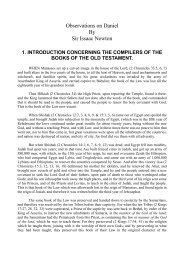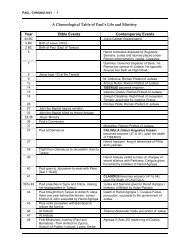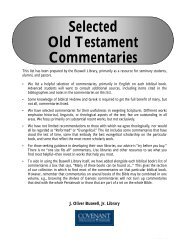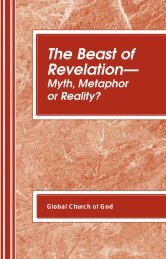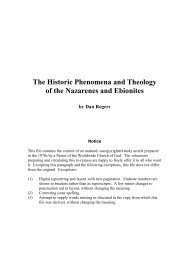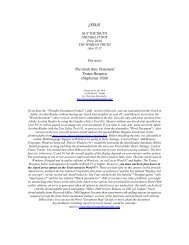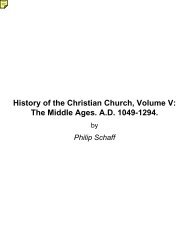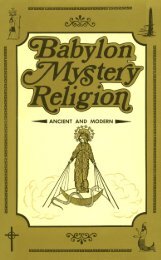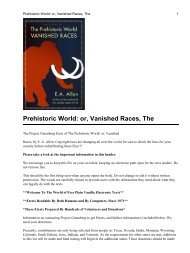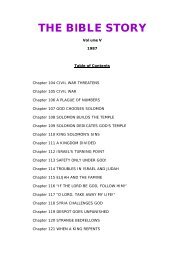Legends of the Shawangunk2 JR.pdf - Friends of the Sabbath ...
Legends of the Shawangunk2 JR.pdf - Friends of the Sabbath ...
Legends of the Shawangunk2 JR.pdf - Friends of the Sabbath ...
You also want an ePaper? Increase the reach of your titles
YUMPU automatically turns print PDFs into web optimized ePapers that Google loves.
New Paltz. 155<br />
especially after he proclaimed <strong>the</strong> celebrated Edict <strong>of</strong> Nantes in 1598. Louis XIII<br />
repeatedly violated its stipulations; and a formal revocation <strong>of</strong> <strong>the</strong> Edict was made in<br />
1685, which cost <strong>the</strong> lives <strong>of</strong> 10,000 <strong>of</strong> <strong>the</strong> Huguenot people, who perished at <strong>the</strong> stake,<br />
gibbet, or wheel. Thousands fled to o<strong>the</strong>r lands for refuge, especially to <strong>the</strong> Lower<br />
Palatinate, or Pfaltz, along <strong>the</strong> river Rhine. Some <strong>of</strong> <strong>the</strong> persecuted Hollanders likewise<br />
fled to <strong>the</strong> Lower Palatinate, and when <strong>the</strong>y subsequently returned to Holland <strong>the</strong><br />
Huguenots accompanied <strong>the</strong>m, and both finally emigrated to America. These two<br />
peoples were attracted to each o<strong>the</strong>r by reason <strong>of</strong> <strong>the</strong>ir adoption <strong>of</strong> <strong>the</strong> same religion, and<br />
this fellowship was rendered still more firm in consequence <strong>of</strong> <strong>the</strong> free intermarriage<br />
among <strong>the</strong>m. This accounts for <strong>the</strong> presence <strong>of</strong> Dutch physiognomies with French<br />
names, observable, even at <strong>the</strong> present day, among <strong>the</strong> congregations in localities where<br />
are found <strong>the</strong> posterity <strong>of</strong> <strong>the</strong> once persecuted Huguenots.<br />
There seems to be no definite information as to <strong>the</strong> course <strong>the</strong> Huguenots took in<br />
coaxing to America. They were hospitably received by <strong>the</strong> Dutch at Wiltwyck, or<br />
Wildwyck, <strong>the</strong> modern Holland for wild retreat, or wild parish, from its primitive and<br />
rough appearance. Soon after <strong>the</strong> granting <strong>of</strong> <strong>the</strong> New Paltz patent <strong>the</strong> Huguenots set out<br />
for <strong>the</strong>ir new home in <strong>the</strong> wilderness. Their weary way lay through <strong>the</strong> trackless forests;<br />
and <strong>the</strong>ir families and household goods were conveyed in wagons so constructed as to<br />
answer <strong>the</strong> double purpose <strong>of</strong> transportation and shelter. Arriving at a broad meadow on<br />
<strong>the</strong> banks <strong>of</strong> a limpid stream <strong>the</strong>y named <strong>the</strong> place “Tri-Cors,” Three Cars, in allusion to<br />
<strong>the</strong> three primitive vehicles in which <strong>the</strong> possessions <strong>of</strong> <strong>the</strong> exiles were transported. The<br />
river itself <strong>the</strong>y named Walkill, probably from Wael, one <strong>of</strong> <strong>the</strong> branches into which <strong>the</strong><br />
Rhine divides itself before emptying into <strong>the</strong> North Sea, and Kill, <strong>the</strong> Dutch for river;<br />
while to <strong>the</strong> settlement was given <strong>the</strong> appellation <strong>of</strong> New Paltz, in remembrance <strong>of</strong> <strong>the</strong>ir<br />
ever dear Pfaltz—<strong>the</strong>ir ancient home on <strong>the</strong> Rhine. Here, in <strong>the</strong> midst <strong>of</strong> <strong>the</strong> beautiful<br />
alluvial valley, <strong>the</strong> crystal waters <strong>of</strong> <strong>the</strong> river at <strong>the</strong>ir feet, <strong>the</strong> blue dome o£ heaven above<br />
<strong>the</strong>m, and <strong>the</strong> towering hills a gallery <strong>of</strong> attendant witnesses, <strong>the</strong> Huguenot refugee<br />
opened <strong>the</strong> Bible brought from <strong>the</strong>ir old homes, read a lesson from <strong>the</strong> holy book, and<br />
with faces turned toward France, joined in a hearty and joyous thanksgiving to <strong>the</strong> God<br />
that had led <strong>the</strong>m safely thus far, and had permitted <strong>the</strong>m once more to brea<strong>the</strong> <strong>the</strong> air <strong>of</strong><br />
religious freedom.<br />
The first conventional act having been that <strong>of</strong> public worship, it was resolved that<br />
<strong>the</strong>ir first building should be a church. This was built <strong>of</strong> logs, and was also used as a<br />
school-house. Temporary residences were at first put up an <strong>the</strong> west bank; but <strong>the</strong><br />
Indians advised <strong>the</strong>ir removal to <strong>the</strong> higher ground on <strong>the</strong> opposite side, as <strong>the</strong> place first<br />
chosen was subject to overflow during <strong>the</strong> spring freshets.<br />
From a minute in French, still in possession <strong>of</strong> <strong>the</strong> church, we find that on January<br />
22, 1863, M. Pierre Daillé, Minister <strong>of</strong> <strong>the</strong> Word <strong>of</strong> God, arrived and preached twice at<br />
New Paltz. He proposed that <strong>the</strong> people choose, by a vote <strong>of</strong> <strong>the</strong> fa<strong>the</strong>rs <strong>of</strong> families, an<br />
elder and a deacon, to aid <strong>the</strong> minister in <strong>the</strong>



